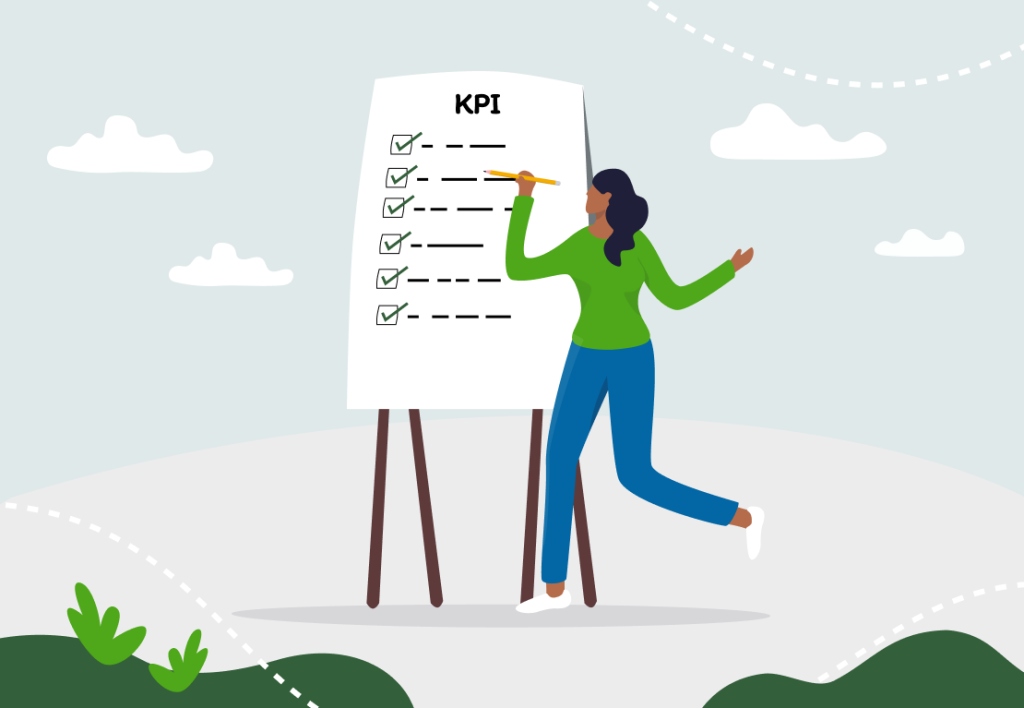The ultimate list of KPI examples and how to successfully implement them

Nearly every company has set goals and a laid out roadmap on how to achieve them. But how to measure if that process is going according to plan? How to measure progress along the way? KPIs are here to help.
In this article, we’ll look at what KPIs are, what to remember when choosing, which ones to use and provide some KPI examples that will be useful to track progress in different areas of your business.
Want to get the most out of your time?
Try DeskTime for free!
Try free for 14 days · No credit card required.
By signing up, you agree to our terms and privacy policy.

What are KPIs, and why are they important?
A key performance indicator (KPI) is a metric used to measure, track, and analyze the way a company is working toward its business goals. There are many types of KPIs that can help translate business processes into tangible data in both numeric and textual forms.
KPIs can be crucial to understanding how your organization is performing in different areas of business, how its resources are being used, and how to improve its operations to reach certain goals.
Types of KPIs
There are a variety of KPIs that are broken down into categories in order to better target different goals individually. Here’s a commonly known list of key performance indicators that will help you indicate what metrics to focus on:
- Quantitative Indicators
Quantitative indicators are very straightforward and present data in numeric values. It can be percentages, ratios, scores, ratings, and so on.
- Qualitative Indicators
Qualitative indicators, on the other hand, present data in a textual form, such as surveys, questionnaires, and opinions. Qualitative key performance indicators are useful to evaluate employee and customer experience within a company and make improvements where necessary.
- Leading Indicators
Leading indicators are used to predict future trends or an outcome of a project when a change has been introduced. For example, if a company launches a new product, leading indicators can be used to estimate revenue the product may bring in.
- Lagging Indicators
Lagging indicators measure the success or a failure of a process based on historical data and current measures. They are used to look back at a project and conclude whether the strategic decisions made in the beginning have resulted in a desired outcome.
- Input Indicators
Input indicators can be used to gauge how much resources are needed for a process and track their use throughout it. They help to gauge the impact of a project and use resources in an efficient way. Some examples of input performance indicators include determining the number of staff members needed for a project, how much and what equipment to use, or how much money a process will cost.
- Process Indicators
Process indicators, like the name suggests, track the efficiency throughout a process. They are useful to track progress of a project and implement necessary changes along the way if a certain business decision is not performing properly.
- Output Indicators
Output indicators measure the final result of a process. Some examples include revenue, new customers acquired, or improvements within the company.
- Directional Indicators
Directional indicators help to understand where the trends within a process are going. In other words, they are used to determine whether a company is getting better or worse in certain areas and identify patterns that indicate the direction of a process.
- Practical Indicators
Practical indicators are used to evaluate existing processes within a company and their impact on the overall success.
- Actionable Indicators
Actionable indicators measure the ability and commitment of a company to implement change. It is one thing to determine whether or not a process needs improvement, but it’s another to find successful ways to carry out that improvement. For example, actionable indicators can be measured in time needed for implementation or resources used for it.
- Financial Indicators
Financial indicators reflect the economic stability, growth, and success within a company. The best way to implement financial performance indicators is to combine them with other KPIs to get a full picture of the financial status of an organization.
How to use KPIs successfully

Before we dive into examples of key performance indicators, there are a few things to remember.
Regardless of which KPIs you choose to measure progress and success at your company, they need to be clearly measurable and easy to understand. In that way, employees will have clear objectives and they will be able to focus on improving measures, rather than trying to understand them.
Speaking of employees, it is important to let them in on discussion about what KPIs would be the most valuable to use within your company. Involving employees in the decision-making process will motivate them to succeed. On top of that, remember that tracking multiple KPIs at the same time can be stressful, so make sure to assign each KPI to a different individual.
It is also important to ensure frequent monitoring in case some KPIs need tweaking along the way, as well as readiness to pivot to a different KPI completely. Many companies will try to monitor their KPIs on spreadsheets shared among employees, but that allows for a bigger margin of error. Instead, try using a subscription-based CRM software that can analyze data and improve everything from customer relations to sales to marketing campaigns.
Lastly, choosing to use more KPIs is not always better. Keeping track of an excessive amount of KPIs can backfire and overwhelm employees with too much data, so choosing quality over quantity is crucial when it comes to your company’s individual goals.
A list of key performance indicator examples

Now that we have determined what KPIs are, explored a commonly known list of key performance indicators, and looked at some strategies on how to use these metrics to utilize them effectively, let’s jump into some examples of KPIs.
It’s important to note that there are hundreds of KPI examples out there and spelling out all of them would be unproductive and overwhelming. We have compiled a list of most commonly used KPIs based on five areas of business — marketing, sales, finance, project management, and customer service.
Examples of Marketing KPIs
- Marketing ROI
Marketing return on investment (ROI) might be the most common KPI to measure how effective the marketing efforts are and which ones are performing better than others. It can be calculated using this simple formula:
(Sales revenue – Marketing cost) / Marketing cost = ROI
- Traffic to MQL ratio
Traffic to marketing qualified lead (MQL) or traffic-to-lead ratio looks at the overall traffic to a platform and compares it to qualified leads that come out of it. It’s a useful measure because it helps to identify which marketing channels are the most profitable and worth continuing or increasing investment in and which ones are underperforming and need improvement.
- Customer acquisition cost
Customer acquisition cost (CAC) refers to the total cost of acquiring a customer. It is valuable to understand what it costs to advertise for new customers and how much of the company’s resources go into it.
- Customer lifetime value
Beyond knowing what it costs to acquire a customer, it is also important to know what the customer brings to the company. Customer lifetime value (CLV) is a good measure to use when looking at the overall revenue each customer brings in individually.
- Customer engagement
Engagement is another valuable metric to track marketing success. Customer engagement can be measured in many ways, including platform views, shares, and likes, how much time they spend on a page, bounce rate (clicking through tabs on a website), etc.
Examples of Sales KPIs

- Sales growth
The growth of sales can be measured on a daily, monthly, and yearly basis. Sales growth KPI is a very tangible metric that provides straightforward numbers and allows managers to act on trends, as well as gives sales teams clear goals. Use this formula:
((Current period net sales – Previous period net sales) / Previous period net sales) x 100 = Sales growth
Subtract the net sales of the prior period from that of the current period. Then, divide the result by the net sales of the prior period. Multiply the result by 100 to get the percent sales growth.
- Average profit margin
Average profit margin KPI measures how overall revenue from sales results in actual profit. In order to calculate the average profit margin, you simply need to subtract the costs of a process from its revenue.
- Lead-to-sale rate
The lead-to-sale rate is useful to determine how many potential leads convert to sales. This KPI can be used to evaluate the effectiveness of the sales team and what marketing platforms bring in the most customers that bring in revenue.
- Product performance
Which products are the best-selling? Which ones generate the most revenue and in what context? How do different products bring in sales based on marketing campaigns? All of these questions can be answered by measuring product performance.
- Sales per rep
Like it or not, sales is a competitive department. The sales per rep KPI can help identify which sales reps are on the top of their game and which ones are underperforming and need individual performance improvement.
Examples of Finance KPIs

- Gross profit margin
Gross profit margin KPI is a measure that looks at how profitable a product is. It is a ratio that shows the percentage of revenue that is left over after subtracting the cost of making a product. The formula is simple:
(Revenue – Cost of Sales) / Revenue x 100 = Gross Profit Margin
- Net profit margin
Net profit margin KPI goes a step further and shows what percentage of overall revenue and other income is left over after subtracting all costs, including production, operation, interest, and taxes by using the same formula above.
- Operating cash flow
Operating cash flow determines how much cash there is in the budget to either continue and grow operations or detect where additional funding is needed to maintain the ongoing operations.
- Working capital
This metric measures the overall financial health of a company and evaluates the readily available assets that can be used for financial liabilities. In order to calculate the working capital of your organization, subtract the current liabilities from current assets.
- Seasonality
If your company is affected by high and low seasons, consider looking at the seasonality of a product. This KPI is useful to have when analyzing the financial picture of the whole year and planning out product and campaign launches.
Examples of Project Management KPIs

- Time
When it comes to project management, measuring how much time is spent in different areas of operations is crucial. In order to do so, you can measure how much time was planned to complete a project vs the actual time spent, how much time was spent on specific tasks, how many deadlines were missed or pushed back, etc.
All of these time measures can help better understand time management within a company and plan for future projects. DeskTime is here to help.
- Budget variance
Another focus area where KPIs are useful is budgeting for projects. Consider this: How much did we budget for a project and how much did it actually cost? How much time did it take to plan a budget? How many versions of the budget needed to be revised before finalizing it? These questions can be answered by using KPIs such as cost performance index (CPI), cost variance (CV), and earned value (EV).
- Milestones
Dividing big projects into smaller milestones is another way to measure success. You can set a number of milestones throughout the project and measure how many of them were missed or completed, how frequently they need to be set, and how they improved overall productivity during the process.
- Resources
Lastly, it’s important to be aware of the resources needed to achieve a goal. Resource KPIs refer to understanding how many employees are available and/or needed for a project, how much training and research is required, and how effectively resources were utilized throughout the process.
Examples of Customer KPIs

- First response time
First response time (FRT) measures how long it takes for a company to provide an initial response to a customer. Whether it be response time to a call or an email, customer experience significantly improves when their request is dealt with in a timely manner and it increases the likelihood of a customer to bring in revenue.
- Customer retention rate
Customer retention rate (CRR) is used to determine how a company retains customers. In order to measure how many customers come to do repeated business with your company and remain loyal, divide the number of retaining customers by the number of overall customers.
- Customer Satisfaction Score
Many businesses opt for surveying their customers after an interaction or a service in order to determine the customer satisfaction score (CSAT). This KPI will be useful for those looking for weak spots in their customer service experience and ways to improve interactions. These surveys normally offer a simple scale that does not require an in-depth answer from the customer.
- Average Resolution Time
Average resolution time (ART) is a metric that refers to the average time a customer’s complaint is resolved. ART takes it a step beyond the first response time by focusing on efficiency during the interaction and striving to decrease resolution time in the long run.
- Customer Effort Score
Finally, customer effort score (CES) measures how easy or difficult it is for a customer to interact with a business and strives to provide data for providing a fast and effortless service. CES, similarly to the KPIs above, can be measured by providing a simple survey that uses a scale asking the customer how easy or difficult the interaction was.

Want your business to thrive?
Boost your team’s productivity and efficiency ratings with time tracking!
Don’t measure for the sake of measuring
No matter what metrics you choose, remember that KPIs are there to improve your business, not to keep track of every single process within it. The key to successfully using KPIs is to choose the ones that work for your business and its goals and not to overcomplicate the process.
Did you find this article useful? Give it a clap!
Psst! You can clap more than once if you really loved it 🙂